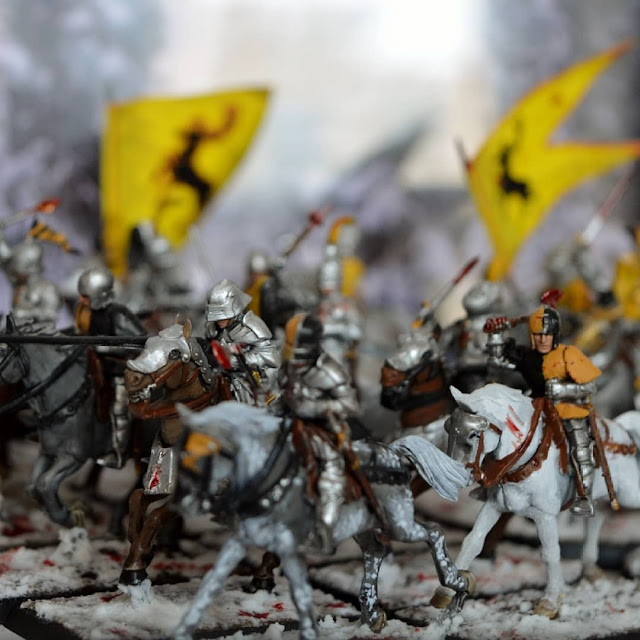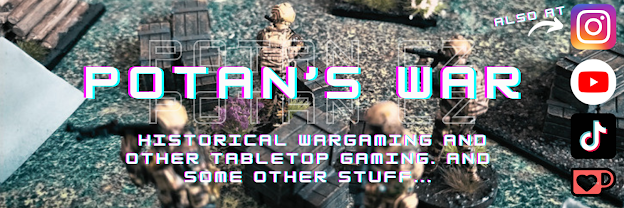Wargaming games can be divided according to many (often overlapping) criteria - activation method, model size, genre, and so on. However, most wargaming games can be universally categorized by the size of the battlefield (or the number of warriors on it) and placed into several boxes that better help determine the type of game before a potential player opens the rules. These are skirmishers, regimental games and army games.
 |
Knights go into battle - A full-sized "army" for a skirmish game, but also a unit for a regimental game. |
Skirmish games
Skirmish, as the name suggests, deals with small skirmishes over a few soldiers. Depending on how many of them there are, it can either be a "regular skirmish", or a straight M2M Skirmish (it is an abbreviation of man to man). In a regular skirmish, several smaller units of a few miniatures play, in M2M each soldier is on his own.
The smaller scale of the battles then allows for game mechanics that could not be applied to larger battles or would make the game unnecessarily complex and lengthy. So models often deal with individual weapon reloads, games usually have some form of enemy spotting, dealing with individual soldiers' viewpoints, and similar little things that can be managed with 10-20 models but not with armies of hundreds of figures.
 |
| A bunch of Indians go to raid an abandoned homestead. Beautiful example of M2M skirmishe in 28mm scale. |
Scenario-wise, you can think of these games as small special forces actions, western stagecoach ambushes, patrol clashes, samurai sword fights, tanker clashes, European adventurers in Africa, and so on.
The advantage of skirmishes is that it's a "starter" game to get started on, and later move on to bigger battles as your army grows. With a squad of Commandos or Space Marine Scouts, you can play skirmishes at first, and then seamlessly incorporate them into a larger "army" - there's even a Kill Team from Warhammer, for example, that was built on this approach.
 |
Just a few models, but it's not skrimish, sir. |
For the number of models, skirmishes should include naval or air games (after all, a clash of five ships is actually a kind of skirmish, isn't it), but they are still referred to by their focus as naval or air games, i.e. naval and air games, and we don't count them in skirmishes at all. It's automatic that you'll be flying or sailing with a few machines and not moving with hundreds of their ilk. Although, there are definitely some exceptions.
Regiment games
When you've had enough of "small games", it's time to move on to regiment games.
As the name suggests, you move entire units around the table, but not necessarily regiments. Individual models are already wholeheartedly part of a large unit that moves, shoots, and dies as a whole. Yes, even dying. Most of the time these games no longer even have separate removal of models after each loss, but collect various pins/shocks/morales and after a certain number they deteriorate and go off the table as a unit. These "game simplifications" in effect make it possible to play even relatively large battles with lots of pieces. Instead of moving five soldiers with individual facing and actions to deal with, you simply move a large unit of 30 soldiers. And there may be ten or more such units on each side of the table...
 |
| Napoleonic Brigades are marching into battle - 28mm battle in Prague Wargames Club. |
As a result, regimental games often already contain rules for grouping units into larger units, which then have to activate together, stick together in coherence, and perhaps even have a common morale.
Large skirmish games
Now that we know what skirmish and regimental games look like, we get a detour back to "large skirmish", which combines elements of both previous modes and (ideally) takes the best of both.
Which is perhaps why large skirmish is one of the most popular levels in wargaming - after all, it includes both Warhammer 40,000 and Warhammer Age of Sigmar.
 |
| Modern Africa in 15mm - a nice demonstration on the border between Large Skirmish and Regiment. |
While small skirmish offers us 5-20 soldiers to play with and regimental games ask us for 300+ soldiers, large skirmish will offer us games where we will have 50-100 soldiers. Enough to use mechanics like shooting soldiers separately in a squad, as well as having them die one by one. However, units already mostly move together, have common morale and activations.
A few examples for all
In Warhammer 40k, the M2M skirmish Kill Team is where the player controls five marine scouts, each acting independently. The regular skirmish was a mod of Combat Patrol, which had the classic W40K rules but was limited to points - one could deploy one's five from last time and add a dozen marines in a transporter.
The classic W40K already falls into the large skirmish box, and the regimented one is then the Apocalypse mod, or the old Epic. Warhammer also offers Aurenautika Imperialis, where the player controls a squadron of fighter planes, but I said above, even though it is a multi-model game, air and naval games are not normally classified as skirmishes.
 |
| A Custodian Captain fighting a bunch of demons could easily be a scene from Kill Team, but this is a photo from classic Warhammer 40K. |
For those unfamiliar with Warhammer, I'll show a similar example in World War II. M2M skirmish is a squad of Commandos going to sabotage a German radar base. A skirmish is a platoon of Commandos fighting for a village against a German platoon. Think of a Large skirmish as fighting for a village with another infantry platoon, ideally supported by tanks. A regimental game is when you start moving platoons that are in companies instead of separate squads.
That's generally how you could divide games in "modern terminology" according to the formation that will be played. While 30 knights does not logically make a platoon, it fits our needs size-wise, so don't be fooled by modern terminology.
So M2M skirmish is a squad game, skirmish is a platoon game, large skirmish is a game from reinforced platoon to company, and regimental skirmish is a game from companies to battalions to brigades. And what happens when you have several brigades or even an entire division on the table? Where to go next?
Army games
Then we have no choice but to move on to the final level of figure wargaming, and that is army games. In these, all the little things like separate pieces are no longer needed. Slowly we don't even care about the units themselves anymore, as everything moves in larger formations of a few hundred soldiers. As a result, most of the rules are already written on 6mm or 3/2mm, or even on tokens. This allows the game to accommodate not just skirmishes or slice battles, but quite large battles with a good degree of abstraction.
 |
| Over 150 Persian cavalry in 6mm - in an armylevel game just protecting the wings of the main army, in a 28mm large skirmish it would make for a separate large battle. |
For example, the armylevel game Age of Hannibal has an infantry base of about 25-30 models as the base unit in 6mm figure scale, which depicts roughly 500-1000 soldiers. So four of these pedestals of 100 models depict 2-4 thousand soldiers. This allows battles of thousands of models to be played and finished in the classic 2-3 hours that is considered standard game time for an afternoon game across scales. Army games already completely ignore the mechanics from skirmish games, but in turn add their own systems that wouldn't make sense in smaller games, such as retreat routes for brigades, camp protections, large formation maneuvers, etc.
 |
| Persian and Greek Shiks clash at Gaugamela in 6mm. There are about 1200 soldiers in the photo (hardly feasible on a larger scale). |
Strategy games
Strategy games get such an honorable mention at the end of the article. All the previous games are still on the tactical level of war, when it comes to the actual combat. Above all of that, there are strategy games, where you move divisions or armies around the map and the battles themselves are already resolved more by modifiers and a few dice rolls. As the logic goes, these are purely token games that don't operate with pieces or just stand in pieces.
A common example would be a game like Axis and Allies or Risk, the more hardcore example being the legendary game The Campaign for North Africa: "The Desert War, 1940-43" about Rommel in Africa, made famous by a sketch in The Big Bang Theory, which takes longer to finish than the historical Afrikakorps campaign.
Originally published in Czech on the ZeStolu portal. All images taken from my Hobby Instagram page #Potan_CZ.

Comments
Post a Comment